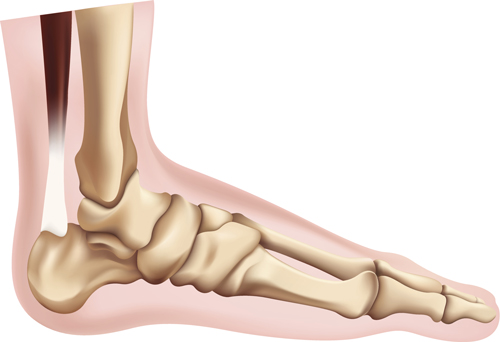
A sprained ankle is a very common injury, with approximately 25,000 people—athletes and non-athletes, children and adults—experiencing it each day. An ankle sprain affects the ligaments , tough elastic bands of tissue on the outside of the ankle that connect the ankle bones to each other and protect the ankle joint from abnormal movements, such as twisting, turning and rolling of the foot.
When a ligament stretches beyond its normal limit, a sprain occurs. While most sprains respond quickly to treatment, up to 40% of patients will develop chronic ankle instability that makes it easy to reinjure the ankle. Grade I sprains (mild) occur when the ligaments are overstretched, but only a small number of fibers are torn. The ankle becomes tender and swollen. The injury will heal by itself with R.I.C.E.—Rest, Ice,Compression and Elevation—but the ankle will likely be more susceptible to re-injury, and some individuals may need to wear an ankle brace during strenuous activity. With grade II sprains (moderate), the ligament is partially torn, but with more fibers involved than grade I, causing swelling, bruising, extensive pain, difficulty bearing weight and joint instability. People with grade II sprains should see a doctor, who may prescribe a splint or Aircast and crutches for several weeks to immobilize the ankle and minimize ankle stress . Nonsteroidal anti-inflammatory drugs, if your doctor agrees, can reduce swelling and alleviate pain. In some cases, prescription pain medications may be needed to provide adequate relief. In grade III sprains (severe), the ligament is completely torn, can using severe pain, widespread swelling and bruising, loss of joint function and an inability to bear weight. People with grade III sprains should follow the R.I.C.E. principles and seek medical attention as soon as possible. Cast immobilization is sometimes required for several weeks to minimize ankle stress, but surgery to repair the ruptured ligament is rarely necessary. For grade I and grade II ankle sprains, starting a two- to six-week rehabilitation program after the first 48 hours is crucial to promote healing, reduce pain and swelling, strengthen the ligament and improve the range of motion. For grade III sprains, a rehabilitation program can be administered and undertaken with care after four weeks and continued over a six-week period. Whatever the severity of your sprain, we can create an individual program of rehabilitation exercises to enable you to resume your normal activities as soon as possible.
